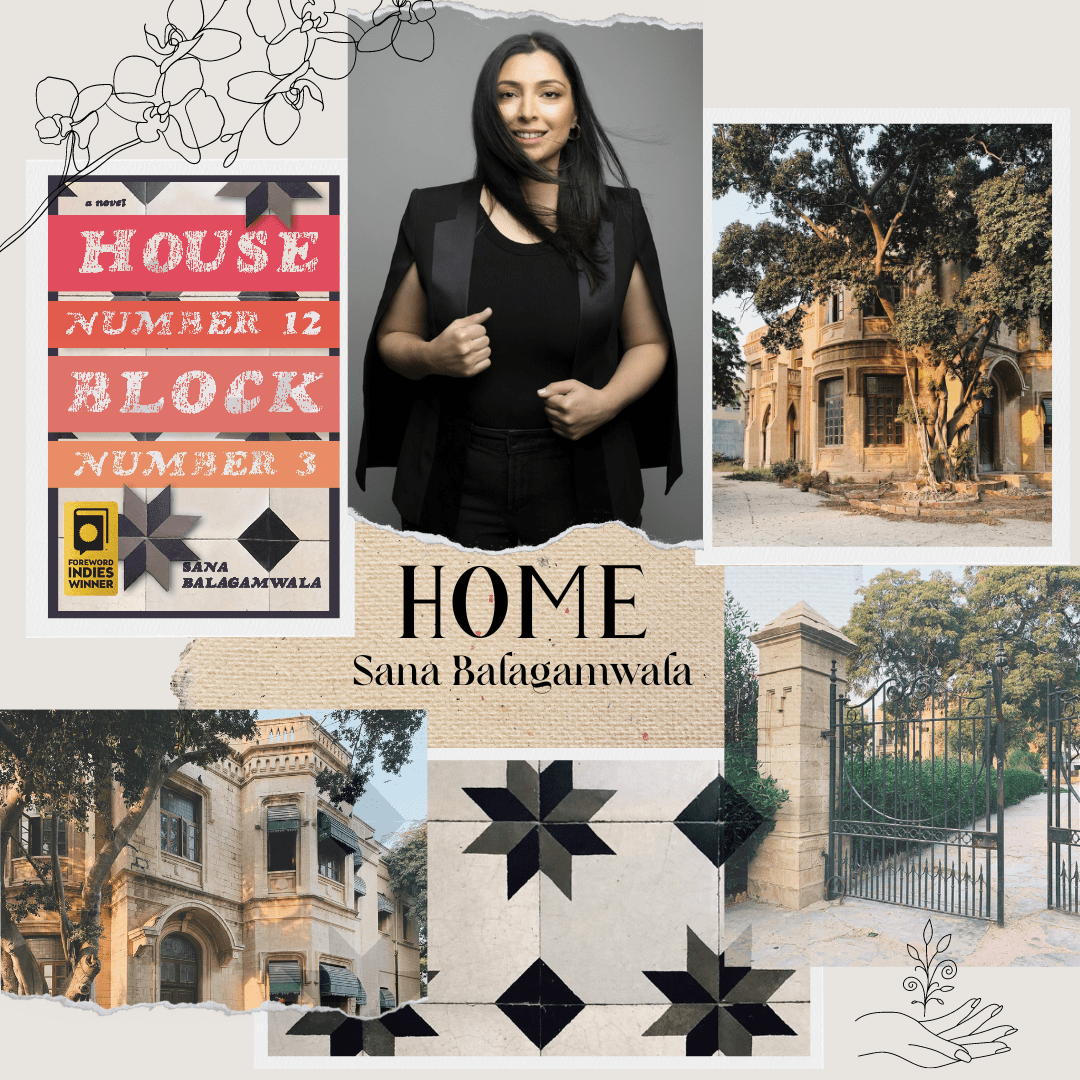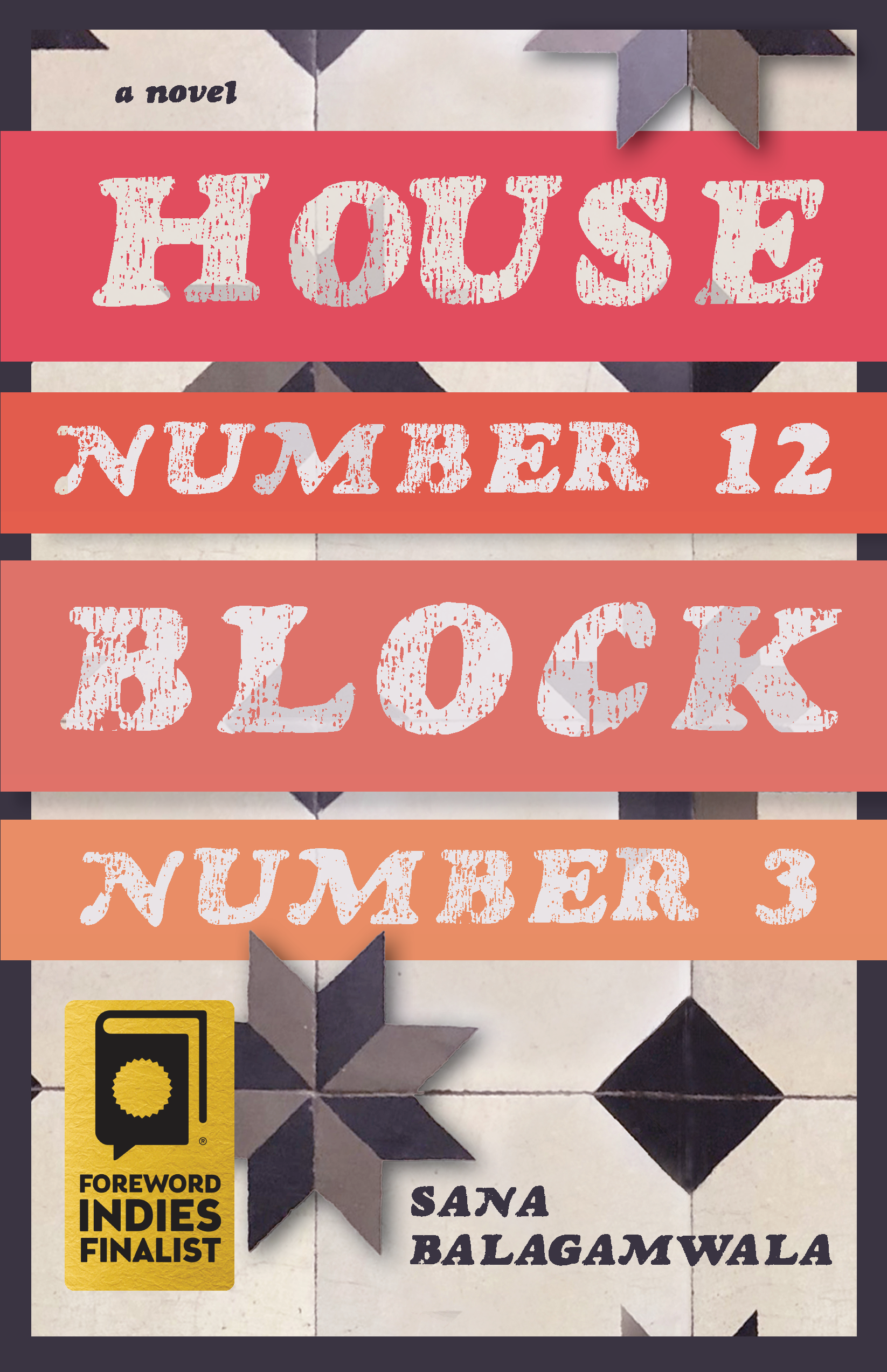
Sana Balagamwala, House Number 12 Block Number 3

HOME
How a house became a narrator and how the significance of “home” is always relevant.
Written by award-winning author, Sana Balagamwala. Balagamwala’s debut novel, House Number 12 Block Number 3 was recently named Foreword Reviews Indie Multicultural Book of the Year!
Going Home
In January, I had the joy and privilege of going back home to Karachi, Pakistan for a book launch in the city that inspired my debut novel. It was a trip that almost didn’t happen because COVID cases had once again started creeping up in numbers–but we picked an outdoor venue, and requested people be masked and vaccinated if they came.
Introducing the novel to my hometown felt surreal; an out of body experience, a homecoming of sorts. There was a sense of intimacy, but also a stripping down of any facade. Here, as I thought about what I would say, I was forced to be brutally honest with myself. I was in a place that knew me so well, a place that had seen me both at my strongest, and at my most vulnerable. In the audience, sat my 3rd Grade teacher; in the front row next to my parents sat the principal from my elementary school. Talk about pressure. Yet, how fitting to talk about home, and the places that shelter us, in a place and amongst those who had, over the years, sheltered me.
Home
As humans we have a reciprocal relationship with the Earth and this in turn manifests in the relationships we have with the places that shelter us, and the places we call home. I always felt my own house was such a big character in my life. I spent my entire childhood and the beginning of my adulthood there, until I moved away at the age of 21. The walls of my house witnessed many firsts, and became inseparable from the joys and sorrows that punctuated life.
My novel began as a personal project; a collection of stories I gathered from my parents, grandparents, aunts, and uncles. My grandparents migrated from India to Pakistan during the partition of 1947. Their stories were so full of what they had to leave behind: toys, valuables, friends, and homes they had felt safe in. As they buried their valuables and fled India, taking what they could easily and safely carry, they hoped to be able to return one day and retrieve their belongings.
Sadly, for most of them that day never came. Home featured so much in their stories as they left one home for the promise and hope of another. Anywhere they could be safe with their families was home: a refugee camp, an abandoned flour mill, a borrowed room from a kind friend or stranger. In my novel, Haji Rahmat is determined not to leave his house in Karachi. because after a turbulent move from India, it was there that he was finally able to make a home for his family. So for him, his house in Karachi became synonymous with hope and independence.
This idea of home, of shelter and of safety, never stops being relevant because wars have always created, and continue to create, displacement and refugees. The loss of a family home and the memories associated with it, the urgency of having to flee with nothing but one’s life, the not knowing if one will ever return home, or if there will be a home to return to; these are stark realities that our human brethren still face today, be in it occupied territories like Palestine and Kashmir or in war stricken regions, like Syria, Yemen, and Ukraine.
House Number 12 Block Number 3
I’ve been asked often about the significance of the narrator in House Number 12 Block Number 3. This time, when I was in Karachi I was asked the same question– why did a house have to narrate the story?
Homes witness histories, both the personal and political. The house then becomes the perfect omniscient narrator, one who sees all and feels so much, but yet does not have control and cannot intervene. As humans we have so often felt that state of powerlessness.
The spaces that shelter us connect us to others. But while the house both protects and shelters, the weight of the secrets it holds can so often feel suffocating. House Number 12 Block Number 3 becomes burdensome for Junaid, who feels the house is cursed, and the cause of the afflictions that trouble his family. He wants to leave his father’s beloved home and move away. It is no surprise that Junaid feels stifled by his house. Indeed the places we live in become living things as they carry the memories of sorrow and trauma within their walls, just as they carry those of joy.
Several years after I left Karachi, my parents sold our childhood home and moved away to a different part of the city. One summer, on one of my trips back, my father and I decided to pay a visit to the old house, so to speak. To our dismay, the new buyers had demolished it and built a modern monstrosity in its place. My father and I both sat there in the car outside the gate in disbelief and sorrow. We had no right to be sad, it no longer belonged to us, but yet, I was devastated. I tried to hold back my tears, because I make it a point not to cry in front of my father. But right there, on that July afternoon, I felt I had lost something irreplaceable. My novel, House Number 12 Block Number 3 is not about my childhood home, but in that moment the only way I could hold on to and honor the memory of the house that I grew up in, was to name my novel after it. So the street address of my childhood home, house number 12 on block number 3, became the title of my novel. I hoped in this way to immortalize the idea of memory, and the memories that house had given me, memories that were fast fading, almost dissipating with the dust that swirled around on that windy July afternoon.
An old friend, who I hadn’t been in touch with over a decade, messaged me when my novel was released. House Number 12 Block Number 3, wasn’t that the address of your old house? she asked. I was surprised. I asked her how she remembered the address. Well your house was always so hard to find, she said because there was no street name, and plus we had some wild memories there. So many of our childhood memories are often connected with our homes, and things that inhabit homes; the lace fringe of the curtains you may have hidden behind as a child, the teacup with that orange flower your father drank his tea from, the odd tear in the cozy armchair.
Life is just a stringing together of those moments really, isn’t it? Moments that seem inconsequential in the present but in retrospect becoming something so much more. So my novel is anchored by those tangible things in House Number 12: Haji Rahmat’s leather armchair, the banisters embedded with onyx which grow organically from the staircase, the jamun tree in the garden. These are the things that anchor memories and make stories possible.
Karachi is one of those cities that is impossible to love, but impossible to hate. It envelopes you within its sprawl, and makes space for itself in your heart, whether you allow it to or not. I feel immensely grateful to have been able to do a reading of my novel in my hometown. As my words echoed in the places that inspired it, I hoped that I had done my city, and the stories it carried within it some semblance of justice.
-Sana
Sana Balagamwala grew up in Karachi, Pakistan. She has a BA in English Language and Literature from the University of Southern California, and a Masters in Education from Loyola Marymount University. She just completed the first year of the Masters of Creative Writing program at Cambridge University.
English is her second language, and she is fluent in Urdu and Hindi. Her debut novel, House Number 12 Block Number 3 was awarded the Foreword Review Indie Multicultural Book of the Year Award. Before embarking on her writing career, she taught Middle School History and Literature. Sana loves old buildings, avoids lizards, and appreciates a good cup of coffee. She lives in Los Angeles, California.
GIVEAWAY!
Click below for a chance to win THREE books from highly-acclaimed Pakistani authors!

Recent Posts
Summer Reading List 2024
Summer Reading List–
12 books that I am adding to my TBR list this summer and 12 Hidden Shelf titles that you should add to yours!
Black History– On This Day in 1959
Black History – On This Day in 1959
The Norfolk 17–February 2, 1959
Sixty-five years ago today, seventeen cautiously brave Black teenagers rocked the foundation of the racist South, accomplishing what many at the time had thought impossible … ending segregation at six public schools in Norfolk, Virginia. If getting there had been a war, being there was horrendous.
2023 Holiday Gift Guide
Unique and creative gifts ideas for the 2023 holiday season!





